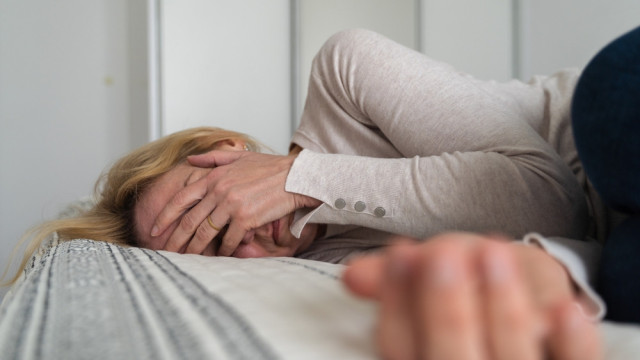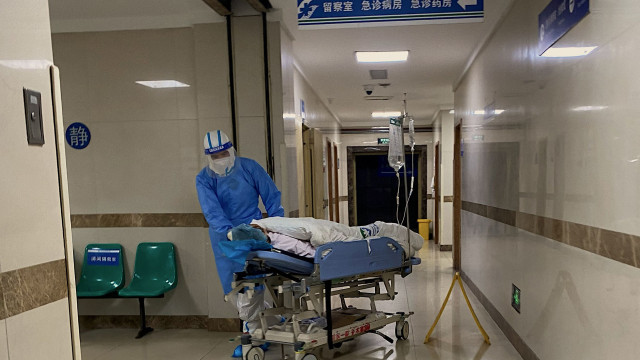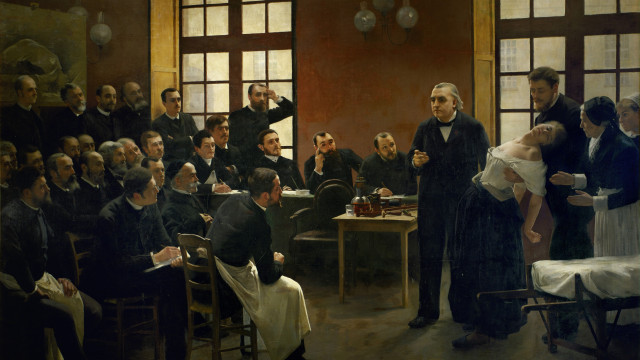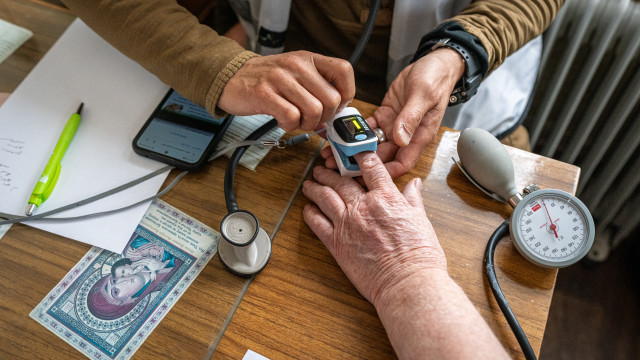





























See Also
See Again
© Shutterstock
0 / 30 Fotos
Dysmenorrhea
- Dysmenorrhea is the medical term for pain or discomfort associated with periods. The pain typically begins one to three days before your period and subsides in two to three days.
© Shutterstock
1 / 30 Fotos
Dysmenorrhea
- Chemicals called prostaglandins produced in the uterus are released into the blood, causing the muscles and blood vessels in and around the uterus to contract.
© Shutterstock
2 / 30 Fotos
Common symptoms
- Common symptoms include a dull, continuous ache in the uterus and pain that radiates to the lower back and thighs.
© Shutterstock
3 / 30 Fotos
Other symptoms
- Some people who menstruate may also experience nausea, dizziness, headaches, and bloating.
© Shutterstock
4 / 30 Fotos
Extreme pain
- While some discomfort is common during menstruation, if you experience extreme pain that prevents you from getting out of bed, for example, it could be a sign of something more serious.
© Shutterstock
5 / 30 Fotos
Extreme pain
- If you are experiencing extreme pain during your period, it is worth starting a pain diary that you can show to a healthcare specialist.
© Shutterstock
6 / 30 Fotos
What makes a painful period worse?
- While painful periods can be hereditary, lifestyle factors like a poor diet, being overweight, or smoking can worsen period pain.
© Shutterstock
7 / 30 Fotos
Avoid caffeine and alcohol
- When menstruating, try to avoid caffeine and alcohol as they can cause your blood vessels to narrow and make cramping worse.
© Shutterstock
8 / 30 Fotos
Track your periods
- Tracking your periods will help you anticipate the pain before it hits. You may wish to create a care package that contains everything you need to limit pain.
© Shutterstock
9 / 30 Fotos
Underlying conditions - PCOS
- If you have PCOS, you may experience heavy bleeding, clots, and severe period pain. It is thought that the hormone imbalance seen in PCOS causes more intense cramps.
© Shutterstock
10 / 30 Fotos
Underlying conditions - Endometriosis
- Endometriosis is a condition where tissue similar to the lining of the uterus grows outside the uterus. Symptoms of endometriosis include very painful periods, bowel pain when using the toilet, and vomiting and diarrhea during menstruation.
© Shutterstock
11 / 30 Fotos
Underlying conditions - Adenomyosis
- Adenomyosis is a condition that causes endometrial tissue in the lining of the uterus to grow into the uterus' muscular wall. It can cause heavy, painful periods.
© Shutterstock
12 / 30 Fotos
Underlying conditions - Fibroids
- Fibroids grow in or on the uterus. They can cause painful or heavy, prolonged periods.
© Shutterstock
13 / 30 Fotos
Underlying conditions - Pelvic inflammatory disease (PID)
- PID is an infection of the female reproductive organs, often caused by bacteria from infections like chlamydia or gonorrhea. It can cause abnormally heavy or painful periods.
© Shutterstock
14 / 30 Fotos
Hormonal contraception
- The contraceptive pill stops the production of hormones involved in ovulation and menstruation, which prevents periods and reduces the chances of getting pregnant.
© Shutterstock
15 / 30 Fotos
Over-the-counter pain relievers
- Nonsteroidal anti-inflammatory drugs (NSAIDs) like ibuprofen or naproxen can help alleviate cramps.
© Shutterstock
16 / 30 Fotos
Regular exercise
- If possible, you may wish to try exercising during your period, as exercise produces endorphins that block pain.
© Shutterstock
17 / 30 Fotos
Hydration
- Research suggests that drinking plenty of water can help reduce bloating, which can make period cramps worse.
© Shutterstock
18 / 30 Fotos
Herbal remedies
- Herbs like ginger, chamomile, and turmeric can help relieve menstrual cramps.
© Shutterstock
19 / 30 Fotos
Sleeping positions
- Sleeping in the fetal position, on your back, or on your side can reduce pressure on the abdominal muscles, which may help alleviate period pain.
© Shutterstock
20 / 30 Fotos
Vitamins and supplements
- Magnesium, vitamin B6, and omega-3 fatty acids may help reduce period pain when taken as supplements.
© Shutterstock
21 / 30 Fotos
Acupuncture
- Some people find relief from period pain through regular acupuncture sessions.
© Shutterstock
22 / 30 Fotos
Pelvic floor therapy
- Pelvic floor therapy involving exercises, stretches, biofeedback therapy, or electrical stimulation to strengthen or relax the pelvic floor muscles has been shown to improve menstrual pain.
© Shutterstock
23 / 30 Fotos
Transcutaneous electrical nerve stimulation (TENS)
- Applying low-voltage electrical currents to the abdomen from a TENS machine may help block pain signals.
© Shutterstock
24 / 30 Fotos
Surgery
- Surgery to remove endometriosis and fibroids is usually successful in relieving menstrual pain. However, there is a chance the pain could return.
© Shutterstock
25 / 30 Fotos
Prescription medication
- For severe pain, stronger pain relievers or hormonal medications may be prescribed by a doctor.
© Shutterstock
26 / 30 Fotos
Heat therapy
- Apply a heating pad or warm compress to your lower abdomen for around 15 to 20 minutes to alleviate cramps.
© Shutterstock
27 / 30 Fotos
Counseling or therapy
- Period pain can significantly impact mental health in some. Talking to a therapist or counselor can provide coping strategies and support.
© Shutterstock
28 / 30 Fotos
Relaxation techniques
- Mindfulness meditation can reduce the sensation of pain, and gentle stretches or yoga can relieve cramping in the abdomen.
Sources: (Nuffield Health) (Mayo Clinic) (Medical News Today)
See also: Strange myths and mystical beliefs about periods
© Shutterstock
29 / 30 Fotos
© Shutterstock
0 / 30 Fotos
Dysmenorrhea
- Dysmenorrhea is the medical term for pain or discomfort associated with periods. The pain typically begins one to three days before your period and subsides in two to three days.
© Shutterstock
1 / 30 Fotos
Dysmenorrhea
- Chemicals called prostaglandins produced in the uterus are released into the blood, causing the muscles and blood vessels in and around the uterus to contract.
© Shutterstock
2 / 30 Fotos
Common symptoms
- Common symptoms include a dull, continuous ache in the uterus and pain that radiates to the lower back and thighs.
© Shutterstock
3 / 30 Fotos
Other symptoms
- Some people who menstruate may also experience nausea, dizziness, headaches, and bloating.
© Shutterstock
4 / 30 Fotos
Extreme pain
- While some discomfort is common during menstruation, if you experience extreme pain that prevents you from getting out of bed, for example, it could be a sign of something more serious.
© Shutterstock
5 / 30 Fotos
Extreme pain
- If you are experiencing extreme pain during your period, it is worth starting a pain diary that you can show to a healthcare specialist.
© Shutterstock
6 / 30 Fotos
What makes a painful period worse?
- While painful periods can be hereditary, lifestyle factors like a poor diet, being overweight, or smoking can worsen period pain.
© Shutterstock
7 / 30 Fotos
Avoid caffeine and alcohol
- When menstruating, try to avoid caffeine and alcohol as they can cause your blood vessels to narrow and make cramping worse.
© Shutterstock
8 / 30 Fotos
Track your periods
- Tracking your periods will help you anticipate the pain before it hits. You may wish to create a care package that contains everything you need to limit pain.
© Shutterstock
9 / 30 Fotos
Underlying conditions - PCOS
- If you have PCOS, you may experience heavy bleeding, clots, and severe period pain. It is thought that the hormone imbalance seen in PCOS causes more intense cramps.
© Shutterstock
10 / 30 Fotos
Underlying conditions - Endometriosis
- Endometriosis is a condition where tissue similar to the lining of the uterus grows outside the uterus. Symptoms of endometriosis include very painful periods, bowel pain when using the toilet, and vomiting and diarrhea during menstruation.
© Shutterstock
11 / 30 Fotos
Underlying conditions - Adenomyosis
- Adenomyosis is a condition that causes endometrial tissue in the lining of the uterus to grow into the uterus' muscular wall. It can cause heavy, painful periods.
© Shutterstock
12 / 30 Fotos
Underlying conditions - Fibroids
- Fibroids grow in or on the uterus. They can cause painful or heavy, prolonged periods.
© Shutterstock
13 / 30 Fotos
Underlying conditions - Pelvic inflammatory disease (PID)
- PID is an infection of the female reproductive organs, often caused by bacteria from infections like chlamydia or gonorrhea. It can cause abnormally heavy or painful periods.
© Shutterstock
14 / 30 Fotos
Hormonal contraception
- The contraceptive pill stops the production of hormones involved in ovulation and menstruation, which prevents periods and reduces the chances of getting pregnant.
© Shutterstock
15 / 30 Fotos
Over-the-counter pain relievers
- Nonsteroidal anti-inflammatory drugs (NSAIDs) like ibuprofen or naproxen can help alleviate cramps.
© Shutterstock
16 / 30 Fotos
Regular exercise
- If possible, you may wish to try exercising during your period, as exercise produces endorphins that block pain.
© Shutterstock
17 / 30 Fotos
Hydration
- Research suggests that drinking plenty of water can help reduce bloating, which can make period cramps worse.
© Shutterstock
18 / 30 Fotos
Herbal remedies
- Herbs like ginger, chamomile, and turmeric can help relieve menstrual cramps.
© Shutterstock
19 / 30 Fotos
Sleeping positions
- Sleeping in the fetal position, on your back, or on your side can reduce pressure on the abdominal muscles, which may help alleviate period pain.
© Shutterstock
20 / 30 Fotos
Vitamins and supplements
- Magnesium, vitamin B6, and omega-3 fatty acids may help reduce period pain when taken as supplements.
© Shutterstock
21 / 30 Fotos
Acupuncture
- Some people find relief from period pain through regular acupuncture sessions.
© Shutterstock
22 / 30 Fotos
Pelvic floor therapy
- Pelvic floor therapy involving exercises, stretches, biofeedback therapy, or electrical stimulation to strengthen or relax the pelvic floor muscles has been shown to improve menstrual pain.
© Shutterstock
23 / 30 Fotos
Transcutaneous electrical nerve stimulation (TENS)
- Applying low-voltage electrical currents to the abdomen from a TENS machine may help block pain signals.
© Shutterstock
24 / 30 Fotos
Surgery
- Surgery to remove endometriosis and fibroids is usually successful in relieving menstrual pain. However, there is a chance the pain could return.
© Shutterstock
25 / 30 Fotos
Prescription medication
- For severe pain, stronger pain relievers or hormonal medications may be prescribed by a doctor.
© Shutterstock
26 / 30 Fotos
Heat therapy
- Apply a heating pad or warm compress to your lower abdomen for around 15 to 20 minutes to alleviate cramps.
© Shutterstock
27 / 30 Fotos
Counseling or therapy
- Period pain can significantly impact mental health in some. Talking to a therapist or counselor can provide coping strategies and support.
© Shutterstock
28 / 30 Fotos
Relaxation techniques
- Mindfulness meditation can reduce the sensation of pain, and gentle stretches or yoga can relieve cramping in the abdomen.
Sources: (Nuffield Health) (Mayo Clinic) (Medical News Today)
See also: Strange myths and mystical beliefs about periods
© Shutterstock
29 / 30 Fotos
Period pain: causes, symptoms, and treatment
Recognizing and coping with menstrual pain
© Shutterstock
It's common to have some degree of pain or discomfort before or during menstruation. During your period, the uterus contracts and expels its lining, and pain can occur during this process, lasting up to three days and affecting your daily activities. However, period pain can also be caused by an underlying condition like endometriosis.
If you're interested to learn about painful periods and their causes, this gallery has the answers. Click to find out more.
RECOMMENDED FOR YOU




























MOST READ
- Last Hour
- Last Day
- Last Week








